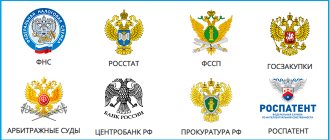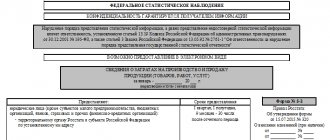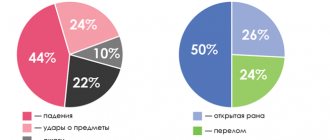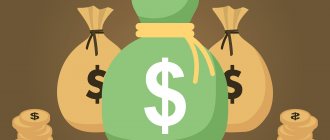Order of the Federal Tax Service of Russia dated May 30, 2007 No. MM-3-06/333 approved the so-called Concept of a planning system for on-site tax audits. It allows you to understand to what extent your business is at risk of being subject to an on-site audit by tax authorities. One of the main criteria for this is profitability by type of activity. In mid-May 2021, the Russian Tax Service published fresh indicators of safe profitability by type of economic activity for 2021. We provide a complete list of them in this review (can be downloaded) so that each company (IP) can compare them with its value.
Main
✅ Profitability by type of economic activity is used by the Federal Tax Service to select taxpayers for conducting an on-site tax audit
✅ Two approaches to determine profitability:
✔ using the Federal Tax Service service “Tax calculator for calculating the tax burden”
✔ based on the Concept of the planning system for on-site tax audits
✅ Profitability can be calculated based on financial reporting indicators
What types of activities are included?
Appendix No. 4 to the said order traditionally establishes the profitability of ordinary activities. Now - for 2021 (updated every year). Ask why only ordinary ones? The fact is that, purely physically, tax authorities are not able to cover all types of activities mentioned in OKVED-2.
Also, tax authorities, of course, are primarily interested in the profitability of the main activity as a criterion for inclusion in the field department’s plan.
Also see “On-site tax audit period: what they will come to see.”
How to increase profitability - methods that work
If profitability indicators are low or even negative and do not suit business owners and investors, there are ways to improve the company’s performance:
- Increasing production capacity - by purchasing new or improving existing equipment, production volume increases and profits increase. The use of the latest technologies in equipment increases labor productivity and saves labor resources. Improving the quality of goods leads to increased consumer demand and increased sales. Reducing production costs - you need to find suppliers offering to supply raw materials or goods for resale on favorable terms. At the same time, the reduction in cost should not affect the quality of goods. Developing and improving a company's marketing policy is a useful tool for increasing sales and profitability. A successful marketing strategy dramatically changes the life of a company and brings in hundreds, if not thousands, of customers. For example, she created a soda machine that asks for a hug; for hugging the machine, a person received a can of the drink for free. This marketing campaign increases customer loyalty to the company, which brings real money and increases profitability.
Promotion and advertising tools are very different: promotions, discounts, competitions, coupons, free distribution of product samples. You can use social networks or banners, create a recognizable trademark or brand. Developing your own product that interests the buyer guarantees good profits.
What is the tax burden
This term refers to the share of revenue paid by the enterprise to the budget. Often, based on the value of this coefficient, the tax office understands whether the business is being conducted fairly. The Federal Tax Service calculates average load values for each type of activity and publishes tables with coefficients.
Banks also use the value of the tax burden when they decide to issue a loan or service a company. If the amount of payments to the budget from the total turnover of the account is less than that established by law, then the business is considered dishonest.
What affects profitability
Every entrepreneur or business project manager strives to achieve high profitability. But in order to calculate it correctly, you need to take into account the influence of various factors, which can be external or internal.
External factors
External is an impact that can have a beneficial or, conversely, negative impact on the development of the company, but does not depend on the enterprise itself. The manager or owner of the business is forced to look for ways out of the situation that has developed due to external factors, and to adapt to it.
For example: a change in tax legislation - an increase in VAT from 18 to 20% - increases the company's expenses; it has to be spent on reflashing the cash register in order to change the tax rate on the receipt. Since VAT is included in the cost of products and increases it, this reduces effective demand, which can adversely affect the profitability of the company.
The following external factors influence profitability:
- Demand; Location of the enterprise; Competitors; Inflation, worsening economic situation; Sanctions; Changes in legislation; Development of new technologies and others.
The profitability of a company differs depending on its location, for example, in Moscow and Naryan-Mar. Communication with the Nenets Autonomous Okrug is only possible by plane, which increases delivery costs and the final price of products.
If the product is in high demand - for example, flowers before March 8 - the sale will be profitable even with high competition.
Technological innovations - gadgets, video games, household appliances - arouse high interest among buyers and guarantee the seller increased profitability.
The general deterioration of the economic situation in the country, the financial crisis due to the imposition of sanctions, and a sharp rise in inflation reduce the profitability of companies and worsen business development in general.
Internal factors
These are features of the enterprise itself that affect the level of profitability. These include:
- Volume, structure and quality of goods; Conducting or lack of marketing and advertising campaigns; Working conditions and productivity of personnel, skills and abilities of employees, microclimate in the team; Issues of pricing and financial policy of the company; Business reputation of the company and relations with suppliers, clients, regulatory authorities; Organization of logistics: supply, storage and sales of goods; Condition of fixed assets, equipment, etc.
For example, Sozvezdie LLC, which produces printed products, is expanding the production of advertising leaflets, calendars, magazines and books, attracting famous designers and artists to the development, investing in the purchase of new equipment for printing and packaging - this increases the profitability of production. But internal factors such as the lack of promotions, discounts on goods due to underdeveloped marketing, failures in product sales, and violations of obligations to regular customers have a negative impact on the company’s profitability.
How is profitability calculated?
There is a profitability ratio - it shows how efficiently resources are used. This ratio is the ratio of profit to the resources that were invested to obtain it. The coefficient can be expressed in a specific amount of profit received per unit of invested resource, or it can be expressed as a percentage.
For example, a company produces sour cream. 1 liter of milk costs 5 rubles, and 1 liter of sour cream costs 80 rubles. From 10 liters of milk you get 1 liter of sour cream. From 1 liter of milk you can make 100 milliliters of sour cream, which will cost 8 rubles. Accordingly, the profit from 1 liter of milk is 3 rubles (8 R - 5 R).
To calculate the profitability of the “Milk” resource, divide the profit by the cost of the resource: 3 / 5 = 0.6, or 60%.
And another company produces ice cream. 1 kilogram of ice cream costs 200 rubles. To produce it you need 20 liters of milk at the same price - 5 rubles per liter. From 1 liter of milk you will get 50 grams of ice cream, which will cost 10 rubles. Profit from 1 liter of milk is 5 rubles (10 R - 5 R).
Profitability of the resource “Milk” in the production of ice cream: 5 / 5 = 1, or 100%.
Conclusion: the return on resources in the production of ice cream is higher than in the production of sour cream - 100% > 60%.
The profitability ratio can also be expressed in the amount of resources expended that were needed to obtain a fixed amount of profit. For example, to get 1 ruble of profit in the case of sour cream, you need to spend 330 milliliters of milk. And in the case of ice cream - 200 milliliters.
Profitability by industry in Russia
Average profitability
Data on average profitability from 1995 to 2021 look like this (generated on the basis of financial statements, arithmetic average for all enterprises, small businesses excluded):
| Return on assets, % | Profitability of goods, products, works, services sold, % | |
| 1995 | 5.3 | 15.8 |
| 1996 | 1.3 | 4.8 |
| 1997 | 1.7 | 6.3 |
| 1998 | -0.9 | 8.1 |
| 1999 | 5.0 | 18.5 |
| 2000 | 7.6 | 18.9 |
| 2001 | 6.1 | 14.4 |
| 2002 | 4.3 | 10.9 |
| 2003 | 5.9 | 10.2 |
| 2004 | 8.5 | 13.2 |
| 2005 | 8.8 | 13.5 |
| 2006 | 12.2 | 13.2 |
| 2007 | 10.4 | 13.1 |
| 2008 | 5.4 | 13.0 |
| 2009 | 5.5 | 10.8 |
| 2010 | 6.7 | 10.0 |
| 2011 | 6.5 | 9.6 |
| 2012 | 6.1 | 8.6 |
| 2013 | 4.5 | 7.0 |
| 2014 | 2.5 | 7.3 |
| 2015 | 3.7 | 8.1 |
| 2016 | 5.9 | 7.6 |
| 2017 | 3.8 | 6.7 |
| 2018 | 4.7 | 10.7 |
| 2019 | 6.8 | 11.4 |
Data on the chart (red – assets, green – sales):
There is nothing unusual in such a distribution - sales, as current assets, should have greater profitability. But we note that these statistics are not very useful for a specific legal entity - the averaging method turns the average profitability into a “hospital temperature.”
Profitability by year
List of profitability percentages by year and industry:
| 2018 | 2019 | |
| Total | 10,7 | 10,8 |
| Housekeeping | 17,8 | 17,2 |
| Mining | 31,4 | 28,0 |
| Manufacturing | 12,0 | 11,5 |
| Printing | 12,3 | 11,8 |
| production… | ||
| ... coke and petroleum products | 8,8 | 9,7 |
| ...chemical | 25,2 | 22,1 |
| ...medicines | 21,6 | 26,6 |
| ... plastic or rubber products | 7,4 | 8,0 |
| ...non-metallic mineral products | 11,1 | 10,5 |
| ... metallurgical | 25,8 | 21,6 |
| ... computers | 12,0 | 13,3 |
| ... electrical equipment | 8,2 | 7,7 |
| ... automated technology | 3,2 | 6,1 |
| ... cars | 2,3 | 1,9 |
| ... other vehicles | 10,9 | 8,8 |
| ...furniture | 4,9 | 4,6 |
| Electricity, gas, steam, air conditioning | 8,5 | 8,9 |
| Construction | 3,9 | 4,5 |
| Trade | 5,1 | 5,2 |
| Transportation and storage | 8,4 | 7,8 |
| Mail, couriers | 3,0 | 2,0 |
| Hotels, catering | 5,4 | 2,7 |
| Information and communication | 11,7 | 11,9 |
| Finance and insurance | 17,7 | 34,0 |
| Real estate transactions | 18,0 | 18,1 |
| Scientific activity | 12,5 | 13,2 |
| Administrative activities | 15,7 | 40,7 |
| Education | 2,8 | 3,3 |
| Healthcare, social services | 7,0 | 7,4 |
| Sports, recreation, entertainment | -13,2 | -6,1 |
Interestingly, back in 2018-2019, sports, recreation and entertainment showed negative profitability. Most likely, in 2021 the rating of this industry has gone into deep minus.
Profitability by city
Alas, neither Rosstat nor the Federal Statistics service collect data on cities/regions.
Dynamics and coefficients
As for the dynamics, today in Russia it is below average. This may be due to insufficient adoption of technological innovations, improved methods and entry into larger markets.
Here a kind of vicious circle arises when the insufficient quality of the products produced due to the small number of technological improvements creates a low attractiveness of the product. Thus, we can conclude that in order to increase the level of profitability of both a specific enterprise and the industry as a whole, a set of measures aimed at comprehensive improvement is necessary.
Research journal
Svetoshova Ksenia Sergeevna Kuban State Agrarian University
Abstract: The article is devoted to valuation issues and ways to increase profitability. The work analyzes various approaches to determining profitability, indicators and evaluation methods. The main ways to increase profitability are considered, in particular financial controlling. Abstract: Article is devoted to the evaluation and ways to improve profitability. This paper analyzes the different approaches to determining the profitability indicators and evaluation methods. The main ways to increase profitability, in particular, financial controlling
Keywords: company, profit, profitability, cost, financial controlling Keywords: company, profit, profitability, costs, financial controlling
The final, important sign of the overall return on production in a free market economy is profitability and profitability. Profitability management (planning, justification and analysis-control) is one of the main tasks of the enterprise. This indicator allows you to detect errors in business activities, indicate to management the path for further development and identify reserves for maximizing profits [2]. The relevance of this topic is determined by the fact that in modern conditions, without a qualitative analysis of the profitability of an enterprise and identifying factors that influence this indicator, it is impossible to increase the level of income received.
In the scientific literature, two main approaches have emerged to determine profitability.
The first group of economists combines profitability with the category of profit. “Directly related to the category of profit,” notes M.S. Atlas, “is connected the use in a socialist society of another value category - profitability.”
The main question is the impossibility of the concept of profitability as a financial ratio existing without profit.
Tsagolova N.A., Cherkovtsa V.N., Medvedeva V.A., Dzarasova S.S. and many other economists narrowed the concept of profitability, defining it by the management system and profitability of the enterprise. But, to date, not enough research has been conducted on ways to increase the profitability of enterprises in modern Russian conditions.
According to official data from the Federal State Statistics Service, the average profitability of goods sold by Russian enterprises for the period 2011-2015. (products, works, services), calculated as the ratio between the value of the balanced financial result (profit minus loss) from the sale of goods (products, works, services) and the cost of goods sold (products, works, services), taking into account commercial and administrative expenses. There is a decrease in the average profitability of goods sold (products, works, services) of enterprises in the Russian Federation for 2011-2015. Thus, during the period under review, the profitability of enterprises in the Russian Federation decreased by 2.8% and in 2015 this figure was 8.6%, although the profitability of enterprises in 2011 averaged 11.4%, this indicates the existing problem of reducing the indicator and the need to find ways to increase it at Russian enterprises.
Profitability helps to evaluate the efficiency of enterprise management; therefore, the high profit and profitability of the enterprise is largely due to the rationality of management decisions made at the enterprise. Hence, profitability can be discussed as one of the criteria for management quality.
Profitability - the concept comes from the German word “RENTABEL”, which is interpreted as “justifying expenses, expedient from an economic point of view.” This indicator means that the funds received by the enterprise from the sale of its products reimburse the cost and, in addition, provide income. Profitability characterizes the economic efficiency of an enterprise over a certain period of time. Along with the profitability of individual enterprises and branches of production, the socialist economy achieves the highest profitability, inaccessible to capitalism, on the scale of the entire national economy. This means that profitability is determined not from the point of view of individual enterprises or industries and not in the context of one year, but from the point of view of the entire national economy and in the context of a long period of time. The profitability of individual industries and enterprises is of subordinate importance in relation to national economic profitability. Increasing the profitability of individual enterprises and entire sectors of the economy helps to accelerate the pace of development of the entire national economy.”
As noted by the authors A. A. Volodin and N. F. Samsonov, the profitability indicator can be used in the process of profit forecasting, establishing a connection between the amount of profit and the amount of invested capital. Estimated profit is estimated based on the level of profitability in previous periods, taking into account projected changes [3, p. 110]. According to Epstein D., profitability is a complex category. It shows how profitable the company's activities are, and, therefore, the higher the profitability indicators, the more successful the activity. For this reason, the enterprise needs to find new ways to increase profitability in order to ensure the highest performance [4, p. 35]. G.V. Savitskaya gives the following definition in her works that “profitability is a relative indicator that determines the level of profitability of a business.” Thus, profitability indicators determine the efficiency of the organization as a whole, profitability in various areas of activity (production, commercial, investment and others), which in more detail than the organization’s profit characterize the final results of the activity, because their value shows the ratio of the effect to cash or consumed resources [8, p. 229].
Thus, profitability is not only a calculated value and a static indicator, but also a criterion used for a comprehensive assessment of the socio-economic position of an organization in the market. The profit received for different enterprises may be the same, but obtained under different conditions. Thus, this is the reason for using profitability indicators, since they help to evaluate an economic entity without relying on the size and nature of the activity.
In accounting, profitability is considered as a two-component component [6]:
— profitability of business activities, which is the result of operating activities (profitability is influenced by accounting policies);
— potential profitability, presented in the form of income from the ownership of securities, long-term liabilities and inventories.
Therefore, an enterprise is profitable if the revenue from the sale of products is greater than production costs, and the necessary amount of profit is generated for the continuous operation of the organization. Profitability indicators are subject to less distorting influence of inflation than profit indicators, since profitability is the ratio of results and resources.
Analysis of profitability of sales as part of a comprehensive assessment of the effectiveness of the enterprise's results makes it possible to consider profit in several of its types. The ratio of gross profit to revenue shows how much from the sale of products an organization can use to cover selling and administrative expenses. If we consider the profit from sales to revenue, we get the “purity of an analytical experiment,” that is, this indicator is not influenced by such items as other income and expenses.
This indicator helps evaluate the effectiveness of product sales management. In the case of the ratio of profit before tax and revenue, the influence of other factors, including tax, is taken into account. The “quality” of profits will also decrease with the increasing influence of other expenses. Using the amount of net profit in the calculation, we obtain the final indicator in the system of profitability of sales indicators, reflecting the influence of the entire set of income and expenses.
In this regard, increasing the profitability of the organization will be a key area of activity in modern conditions, associated with optimizing existing costs and increasing expected income.
The calculation of planned profitability is made by comparing the volume of gross profit or income of the company with the production costs incurred or with the volume of resources used.
Having carried out a certain analysis of the average level of profitability, it becomes possible to determine which products and which specific divisions of the enterprise create the required level of profitability, and which lead to losses. Such information in a particularly competitive market economy is the most important, since financial indicators will directly depend on the specialization and concentration of production.
An increase in sales profitability is influenced by a decrease in production costs, as well as an increase in the volume of its sales. To increase sales, it is necessary not only to carry out marketing activities, but also to produce products that meet the requirements of consumers and are in stable demand among them.
Each organization must have units that analyze the cost of manufactured products and, at the same time, carry out a large-scale program of measures to reduce it. This work requires an integrated approach, that is, it is necessary to take into account all possible factors that influence the formation of the costs incurred for the production and sale of finished products.
In addition, increasing the profitability of the enterprise and measures aimed at optimizing the use of staff working time have a positive effect.
Thus, enterprises are developing a set of measures that help increase the profitability of the enterprise. Such measures include reducing production costs, using energy-saving or other technologies, as well as technical modernization of the company. In addition, to increase certain profitability indicators, various methods can be used to reduce the cost of finished products or services supplied by the company to the market.
It is important to note that the main ways to increase the profitability of an enterprise also include: increasing sales volume, increasing the price of manufactured products (goods, services), changing the structure of products sold on the market. To implement these methods, the company needs to use innovative sales technologies and a production management structure.
One of these ways to increase profitability in an enterprise is financial controlling. This system ensures the concentration of decisive actions in the main directions of the enterprise’s financial system, which allows identifying deviations of actual results from standard ones, and the use of competent management in order to increase the efficiency of the enterprise. It is controlling that supplies the organization’s management with the necessary information data. In any enterprise, controlling includes such elements as planning, goal setting, monitoring execution, and decision making [9]. Liquidity support is the main task of financial controlling, indicating the enterprise’s readiness to repay debts at any time. Sustainable solvency is achieved along with the required level of profitability.
Financial controlling allows you to measure the maximum deviation of the actual results of financial activities from the planned ones, monitor the implementation of financial tasks established by the system of standards and indicators, develop management decisions to improve financial activities, adjust individual indicators and goals of financial development in accordance with the current market conditions and the external environment, predict, based on the size of deviations, possible deterioration in financial condition and a significant decrease in the pace of development.
Consequently, financial controlling, in addition to internal control of financial transactions, coordinates the relationship between the creation of an information base, financial planning, financial analysis and internal financial control [7].
Along with this, increasing the profitability of the organization can be facilitated by the involvement of audit firms by the company management that can evaluate the business processes that are built in the enterprise, as well as help assess the flow of financial resources. It happens that the low profitability of an enterprise is associated with the dishonest performance by the enterprise’s managers of their functions.
Increasing profitability in conditions of increased competition is the primary task of the enterprise. The main source of the organization's free cash flow is the revenue received by the enterprise as a result of the sale of manufactured products. Hence, the main direction of activity of an economic entity is, first of all, increasing profitability, using the method of reducing possible costs and observing the appropriate savings regime and more efficiently using the resources at the disposal of the organization. These costs determine the level of income and the cost structure. Since the costs of raw materials occupy a significant share in the structure, an increase in the level of profitability of the enterprise and a decrease in the cost of manufactured products will significantly affect the amount of profit received. This makes it possible to obtain increased profits, which will certainly have a positive impact on the break-even indicator of the enterprise.
Thus, increasing the profitability of enterprises in modern conditions takes on a primary role, and the management of organizations needs to use all possible ways to increase this indicator in order to increase profits, which will ultimately affect the improvement of the efficiency of the business entity itself as a whole.
Bibliography
1. Federal State Statistics Service. Official statistics. Finance of Russia. [Electronic resource]: https://www.gks.ru/wps/wcm/connect/rosstat_main/rosstat/ru/statistics/publications/catalog/doc_1138717651859 (access date: 03/01/2016). 2. Ryabtseva K. A. The need and problems of increasing the level of profitability of Russian enterprises // Young scientist. - 2015. - No. 24. — P. 580-582. 3. Volodin A. A., Samsonov N. F., Burmistrova L. A. Financial management (Enterprise finance) [Text]: textbook. - M.: Infra-M, 2011. - 504 p. 4. Epstein D. Profitability of agricultural enterprises in Russia // AIC: Economics and Management. - 2012. - No. 8. - P. 35–38. 5. Golubeva A.A. Ways to increase the profitability of an enterprise // Materials of the VII International Student Electronic Scientific Conference “Student Scientific Forum” URL: www.scienceforum.ru/2015/1183/11212 (access date: 03/10/2016). 6. Krylov E.I., Vlasova V.M., Zhuravkova I.V. Analysis of financial results, profitability and production costs [Text]: textbook. 2014. No. 38. p. 36–44. 7. Fateeva I. A. Controlling as an effective way to increase the profitability of an enterprise // Young scientist. - 2012. - No. 12. — P. 283-285. 8. Savitskaya G.V. Analysis of the economic activity of an enterprise: Textbook. — 3rd ed., revised. and additional - M.: INFRA-M, 2014. - 425 p. 9. Berdnikov A. A. Analysis of profit and profitability of an organization: theoretical aspect // Young scientist. - 2013. - No. 2. — P. 111-113
How to calculate business profitability
You can calculate the profitability of a business using several indicators (capital investments, working capital, investments, sales, etc.) At large enterprises, calculations are made based on the balance sheet lines.
The generalized calculation formula has the form of a fraction, the numerator of which indicates the amount of profit, and the denominator indicates the cost of its formation.
R = P x 100% / I
Where: R – profitability; P – profit; I – costs that form the income of the enterprise.
The smaller the business structure, the easier it is to take into account all the factors affecting its profitability in terms of costs. In other words, analyzing the activities of a company operating with a small number of types of costs is not a problem.
R = P x 100% / (VCm + CCm)
Where: R – profitability; VCm – average annual cost of working capital; CCm is the average annual cost of non-current assets, including fixed assets.
Most often, the annual average values of the costs of working capital (raw materials, components, consumables, energy, etc.) are calculated as the arithmetic average of the states at the beginning and end of the analyzed period. The advantage of a small business is that with a small amount of equipment and a limited range of resources, the same thing can be done with much greater accuracy.
For example, the car worked from January to April, after which it was sold. Its average annual cost will be equal to one-twelfth of the book value multiplied by the number of months of operation:
CCm = CCb x T / 12
Where: CCm is the average annual cost of the main means of production; CCb – book value of the means of production; T – the number of months during which the product was used.
Using the same principle, the average annual value is calculated in the event of forced equipment downtime (for example, due to breakdown).
What is product profitability
This indicator is of paramount importance in the production of commercial products. If you compare the profit brought by a unit of manufactured goods and its cost, then you will get the profitability of a particular product. In turn, profit is equal to the difference between price and cost:
R = P / Q = (PR – Q) / Q
Where: R – product profitability; P – profit brought by the product after its sale; Q – product cost; PR – selling price of the product.
How to calculate the profitability threshold
There is one more indicator necessary when calculating profitability - the break-even point, otherwise the profitability threshold (break-even point (BEP)). This is the volume of products that needs to be sold to cover all expenses. It shows the level of sales at which the entrepreneur will work without profit, but already break even.
When determining the profitability threshold, revenue, as well as fixed and variable expenses, are used. Fixed costs include those costs that do not depend on the volume of production; they always exist, even when production stops: rent, depreciation of equipment, taxes, wages of administration and support staff (managers, accountants, security guards), etc. Variable costs are those that are directly related and change as production volumes increase or decrease. These include: the cost of purchasing raw materials and materials, energy resources, the cost of transport services, the wage fund of the main production workers with all taxes and deductions.
For example, let’s find the profitability threshold for Constellation LLC. Fixed expenses are 45 thousand rubles, variable expenses are 65 thousand rubles. Revenue amounted to 110 thousand rubles.









